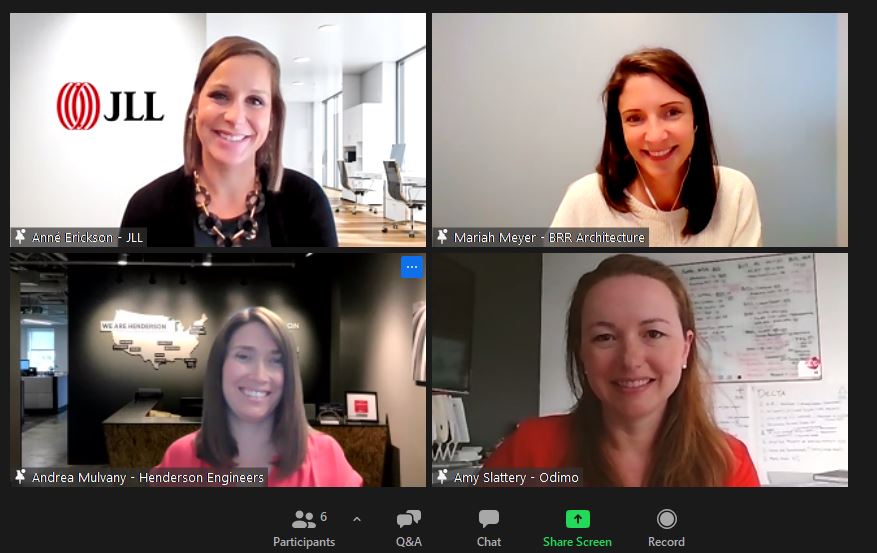As companies evaluate the future of office space and operations in a post- pandemic environment, KC Global Design leading firms came together to share industry trends in office design during a Zoom webinar event on May 19, 2021 as part of the #SafeReturnKC series. View the recording of the webinar here.
The webinar provided an overview of commercial office leasing trends, how those trends are impacting office design, and modifications that can be made to building systems to promote wellbeing in the workplace. Presenters included:
Moderator:
- Amy Slattery, Founder & CEO, Odimo
Panelists:
- Anné Erickson, Vice President, JLL
- Mariah Meyer, AIA, Executive Vice President, BRR Architecture
- Andrea Mulvany, Principal, Henderson Engineers
Office Leasing Trends
Anné shared that 2020 gave us the “largest work from home experiment” but the commercial office market is still alive and well. Office space is key to company operations, culture, employee attraction and retention, and cultivating collaboration.
What employees want:
- 66% of office users want the ability to alternate between different places of work post-pandemic
- 72% want to work from home from time to time
- 40% would like to be able to work from a third-party place (coffee shop, coworking space)
- 64% of employees want to work from the office at least 3 days a week
How employers are responding:
- 47% expect to need the same amount of square footage
- 23% plan to downsize their office portfolio
- 11% expect to grow their office footprint
Kansas City did not see significant increase in employers vacating workplaces. 15 months into the pandemic the vacancy rate is at 14%. Pre-pandemic, it was 12% in Kansas City. The current national vacancy rate is 18%. While companies did not vacate their offices, they postponed plans to relocate them. Lease renewal agreements were up along with requests for shorter lease terms. Relocation agreements went down while subleasing arrangements increased.
Data suggests that employees who work from home more than 2 days a week realize counterproductive impacts on their feeling of work with less engagement, empowerment and increased worry. The office is one of the most powerful tools for recruitment and retention of employees.
Office Design
As a national architecture firm, BRR Architecture has seen how COVID has impacted office spaces from a national standpoint. There has been an increased and intensified focus on flexibility, which was already in play prior to the pandemic. Open office workspace, hoteling stations, traditional private offices, smaller focus rooms, and breakout meeting booths are leading the way with office design. Opportunity for spontaneous collaboration is a major focus and employers are focusing on amenities to attract their employees to the workplace as they compete with the comforts of home. These amenities are all ways employers can offer brain breaks and collaboration amongst their teams:
- Premier coffee offerings
- Residential style breakrooms and kitchenettes
- Outdoor spaces
- Incorporating games and game rooms, basketball goals, pickleball courts, golf options, etc.
Zoning is key to future-proof the office. This allows for limited exposure if a contagion is introduced to the workspace. Modular walls & furniture on wheels can increase flexibility for rezoning as office needs change.
Building Systems
When it comes to building systems, Andrea focused on ways buildings can integrate increased ventilation, increased filtration, and UV lighting. Lack of outside air can lead to increased CO2, cause sleepiness, reduce mental functioning as well as increase viral transmission. Control system modifications are a key way buildings can increase outside air. Andrea shared considerations to make when using MERV and HEPA filters when evaluating the effectiveness of filters in the air handling or duct work equipment. UV light can inactivate viruses and bacteria with proper time and intensity. When installed in HVAC equipment it can provide increased overall air quality. Henderson Engineers decided to increase their filtration and install UV lighting within air handling equipment at their corporate headquarters in response to COVID-19.
Building Control Systems should be used to do the following:
- Monitor humidity levels
- Extend operations
- Occupant heat mapping
- Program for “maximizing” outside air rates when desired
The above are all considerations for physical wellbeing as people return to the office. For employees who plan to work from home, employers need to be intentional about remote work equity and engaging their remote workforce. Employers should consider an investment in remote collaboration tools, ensure managers and meeting leaders are trained in hybrid and virtual meeting etiquette, and explore the latest technologies in virtual reality.
Please click here to download this summary including Q&A and here for the presentation deck.

